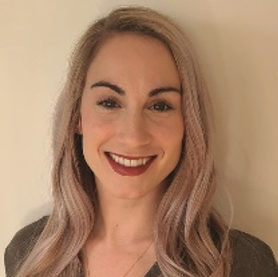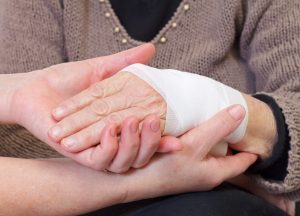 In a world where changing technology and demographics have forced some careers to rapidly evolve or even go extinct, the therapist’s job description has largely gone unchanged. So many of our Tx:Team clinicians, whether 30 days out of school or 30 years on the job, find that their passion for treating patients is very similar to someone who’s been treating for far longer or far less than they have. Often times, academic backgrounds are identical, but clinicians are treating on polar opposite ends of the spectrum when it comes to clinical experience.
In a world where changing technology and demographics have forced some careers to rapidly evolve or even go extinct, the therapist’s job description has largely gone unchanged. So many of our Tx:Team clinicians, whether 30 days out of school or 30 years on the job, find that their passion for treating patients is very similar to someone who’s been treating for far longer or far less than they have. Often times, academic backgrounds are identical, but clinicians are treating on polar opposite ends of the spectrum when it comes to clinical experience.
With all attention focused on the patient, it’s always very exciting for a therapy company to find instances where clinicians, either experienced or inexperienced, are relying on their counterparts for advice and opportunities to collaborate on patient care. The clinical experience component that is so vital to any clinician’s career is helped by the teamwork and collaboration that seems to come naturally to the associates in our facilities.
We’ve paired two clinicians from the same discipline but with different experience levels to get a sense of their team interactions.
We’re appreciative of their input and really proud of their interactions and contributions to their respective teams.
Kelly, OTR, treats in the Assisted Living setting in Charleston, SC. Kelly is a 1992 graduate of Towson State University. She specializes in dementia, low vision, neuromuscular, orthopedics, and urinary incontinence.
Q: As an experienced clinician, what do you feel is one thing that you bring to your team?
The knowledge of my past trial and error situations which have worked for some and not for others. Even with experience, you will run into challenges and need to realize that it’s ok and necessary to try another approach or technique to get the optimal outcome.
Q: What’s one thing you feel you gain from the younger clinicians on your team?
The excitement and energy of being a new therapist.
Q: What advice would you or do you give to new members of your team?
Sometimes there will be some really stressful days, but just take a deep breath and take one patient at a time. Positive energy in a clinic goes a long way. Also, it’s ok to not know something. That’s what other team members, resources, etc. are there for.
Q: Has the role of an OT evolved at all in the time you’ve been treating?
I don’t know how much the role of OT has evolved versus me evolving as an OT. When I started, the focus was self-care and craft based activities. Now, I feel like OT’s have the opportunity to take on more specialized areas at a more technical and educational level such as low vision, urinary incontinence, and power mobility devices. I know in the past, my co-workers (especially PT’s) would joke around about doing needle-work and wood working projects. I haven’t heard that for a long time. Maybe we have earned a little more respect from even within the interdisciplinary team.
Q: What’s one thing you know now that you wish you would have when you started treating?
The education and value of using modalities. My college only offered 1 day for modality education for estim, u/s, and paraffin. I sort of shied away from it for the first several years as an OT. There are certain areas of OT which modalities can make a world of difference. I would have started off much earlier taking courses and getting hands on experience.
Q: Have you found the change to the EMR system difficult? In what ways did you rely on your team in making the transition?
First of all, I had to look up what EMR stands for…guess a new grad would know that. Electronic Medical Records (EMR) was fairly easy for me. I actually learned the most by helping others with their questions and we often figured things out together before asking for help.
Q: The nature of the documentation you’re required to do today, in what ways is it better and worse than when you started treating?
With EMR, I have used a lot more objective functional and pain/disability assessments than I used in the past. It actually helps validate the necessity and makes goal writing more objective like it is supposed to be. With the forms being right on the computer, there is no need to carry around or anticipate the appropriate forms. It also cues you in areas that you may have forgotten to address. The only negative to EMR is when computer systems are down or unavailable for use when you need it. That’s when you wish you could just grab an eval form and a pen.
Q: Could you give an example of a technique that you learned on-the-job and not as a part of your formal clinical education?
In 1997, I worked in a facility where I was assigned to only wheelchair seating and positioning. I knew almost nothing in this area and was so nervous. An experienced OT taught me an unbelievable amount over that year and, without that on-the-job training, I don’t know if I would have ever known what I do now.
Q: What was some of the advice or things you learned from the experienced clinicians back when you started treating?
I was always told to constantly look at the whole person. Whether you are working with UI, low vision, pain, ADL’s, weakness, whatever it is, always step back and look at who that person is, what is important to them and what they want to gain from you.
Q: Why do you think certain techniques of occupational therapy have gone unchanged despite changes in types of medication and imaging that may have taken place in other areas of healthcare?
We work with people. People still have the same bones and muscles, the same brain, and overall, the same physical, cognitive and psychological needs to live, work and play.
Leslie, OTR has been treating at Frederick Memorial Hospital and the outpatient FMH Rose Hill clinic, both in Frederick, MD. Leslie came to Tx:Team following her recent graduation from Bridgewater College and Shenandoah University where she completed her clinical education in two and a half years. Leslie treats both geriatric and pediatric populations, and is a gifted writer, having written a blog on pediatric patients with autism for the company website.
Q: As a younger clinician, what do you feel is one thing that you bring to your team?
I think being a new clinician right out of school, I have a lot of knowledge in regards to current evidence-based practice and new interventions to use with different diagnoses. So, where as an older clinician may have a lot of experience, I’m bringing forward that new research and new evidence-based information to the clinic.
Q: What’s one thing you feel you gain from the experienced clinicians on your team?
It’s really cool that this job has the opportunity for me to work both in the outpatient setting and in the acute setting. I don’t have as much experience in the acute setting, but the OTs there have really taken me under their wing. One of the big things that I picked up over there was the verbiage they would use to educate patients. It was very concise and to the point and it really got the message across in that setting, especially in regards to orthopedics and precautions as far as final preparations to really educate their patients and keep them safe before going home.
Q: What advice would you or do you give to new members of your team in terms of relying on more experienced clinicians?
I know a lot of therapists, myself included, who want to get everything done and learn everything in the first day, but it really is a learning experience. It is a process where you’re going to make a few mistakes along the way, but it’s okay. It’s been instilled in me that I’m still new, and I’m still learning, and they can fix documentation mistakes. Learning a new EMR system is hard for anyone, and so when you’re starting out of school and you’re a new clinician, you’re not only learning to be a new therapist and learning a new job, you’re learning all the procedures along with it, so just be patient and know that it will become routine and everything will fall into place.
Q: How valuable have you found clinical experience to be in your career thus far?
Experience is very important and, even in the evaluation itself, you pick up verbiage when you’re around certain clinicians it’s really helpful and it kind of becomes a script for you to use as you’re going through your evaluation. When you’re used to the same verbiage and repeating yourself with every new evaluation that you do, asking the same questions, it becomes habit and routine. You make sure you’re covering all your bases thoroughly, evaluating all different areas of need for the patient.
Q: Do you feel like using an EMR system is easier for you as a newer clinician?
Our EMR system is pretty unique, and I feel I’m getting a lot of support from the older clinicians as far as navigating through the EMR system just because it has many layers. However, in terms of technology, I do feel that I am able to help other clinicians find those evidence-based research articles by going through a lot of the university databases. I think in that aspect, I’m helpful.
Q: What’s one thing you know now that you wish you would have when you started treating?
I think for any career you’re still learning each day and, when I’m treating a patient, it sparks my interest to research further. I know as I continue to grow and gain more years of experience, I’m going to continue to have to go back to my research and my textbooks to find some of the answers to the questions that my patients spark in me or other questions that I may find interesting as far as diagnoses go and interventions.
Q: Did you have a certain fear coming out of therapy school?
There was some apprehension in that working with the geriatric population, there’s that age difference and although I am young, I appear a lot younger to some of my patients that I’m working with and it’s really important to establish that rapport with your patients, and fill that gap or that bridge between the two of you. And I think through my first few days of working, I really felt comfortable building that rapport with my patients and treating them individually and making sure my therapy is very client-centered.
Q: Could you give an example of a technique that you learned on-the-job and not as a part of your formal clinical education?
I think some of the educational components I’ve learned in working with the orthopedic patients at the hospital and in the acute care setting, and also along the lines of orthopedics, at FMH Rose Hill, we have a certified hand therapist, so I’ve been doing my best to pick up tidbits from him as far as splinting, to strengthen knowledge in my area of practice.
Q: What do you think you may be learning ten years from now from an incoming therapist?
Manual Therapy techniques change often, so I can imagine looking to them for the most current Manual Therapy techniques and, again, the evidence-based research because it’s so important to our field.
Q: Why do you think certain techniques of occupational therapy have gone unchanged in comparison to some of the career types that have evolved over time within and outside of healthcare?
I think, in general, occupational therapists are really unique. I think we all have a passion for the humanities. What drew me to occupational therapy is that it incorporates a lot of my different loves: the health field, architecture and modeling, art, working with children and the education component there. It’s a very creative field and I feel that all OTs have the passion for a lot of different fields in life. I don’t really think that our field has changed much, of course, there’s new research that comes out that helps change how we treat our patients a little bit, but at the same time, I think our roots of occupational therapy, based in psychology and the basis of educating and adapting ways to complete purposeful and meaningful activities. I think that’s where the core of occupational therapy is and I don’t think it’s changed so much in that regard.
 ACL injuries are becoming more and more common in the young athlete, but did you know that female athletes are up to 10 times more likely to experience an ACL injury compared to men? This may be due to the anatomy and biomechanics of the female knee joint. Often due to wider hips and a smaller groove at the bottom of the femur where the ACL inserts, the ACL in the female knee may experience greater stress and further restriction during twisting, jumping, changing direction, and landing movements compared to men. Other contributors to increased risk of injury include weakness of the posterior chain musculature (glutes and hamstrings) and ligament laxity during hormone cycles. Recent studies have found that woman may be more susceptible to ACL injury just prior to ovulation compared to the follicular phase due to increased ligament laxity.
ACL injuries are becoming more and more common in the young athlete, but did you know that female athletes are up to 10 times more likely to experience an ACL injury compared to men? This may be due to the anatomy and biomechanics of the female knee joint. Often due to wider hips and a smaller groove at the bottom of the femur where the ACL inserts, the ACL in the female knee may experience greater stress and further restriction during twisting, jumping, changing direction, and landing movements compared to men. Other contributors to increased risk of injury include weakness of the posterior chain musculature (glutes and hamstrings) and ligament laxity during hormone cycles. Recent studies have found that woman may be more susceptible to ACL injury just prior to ovulation compared to the follicular phase due to increased ligament laxity.


 Are you afraid to leave your home for fear of not making it to the next bathroom or leaking? Do you feel something bulging in your vagina or have you been diagnosed with pelvic prolapse? Do you suffer from pelvic pain which affects your lifestyle and intimacy? Do you skip the jumping jacks or walk instead of run during your exercise routine?
Are you afraid to leave your home for fear of not making it to the next bathroom or leaking? Do you feel something bulging in your vagina or have you been diagnosed with pelvic prolapse? Do you suffer from pelvic pain which affects your lifestyle and intimacy? Do you skip the jumping jacks or walk instead of run during your exercise routine?




